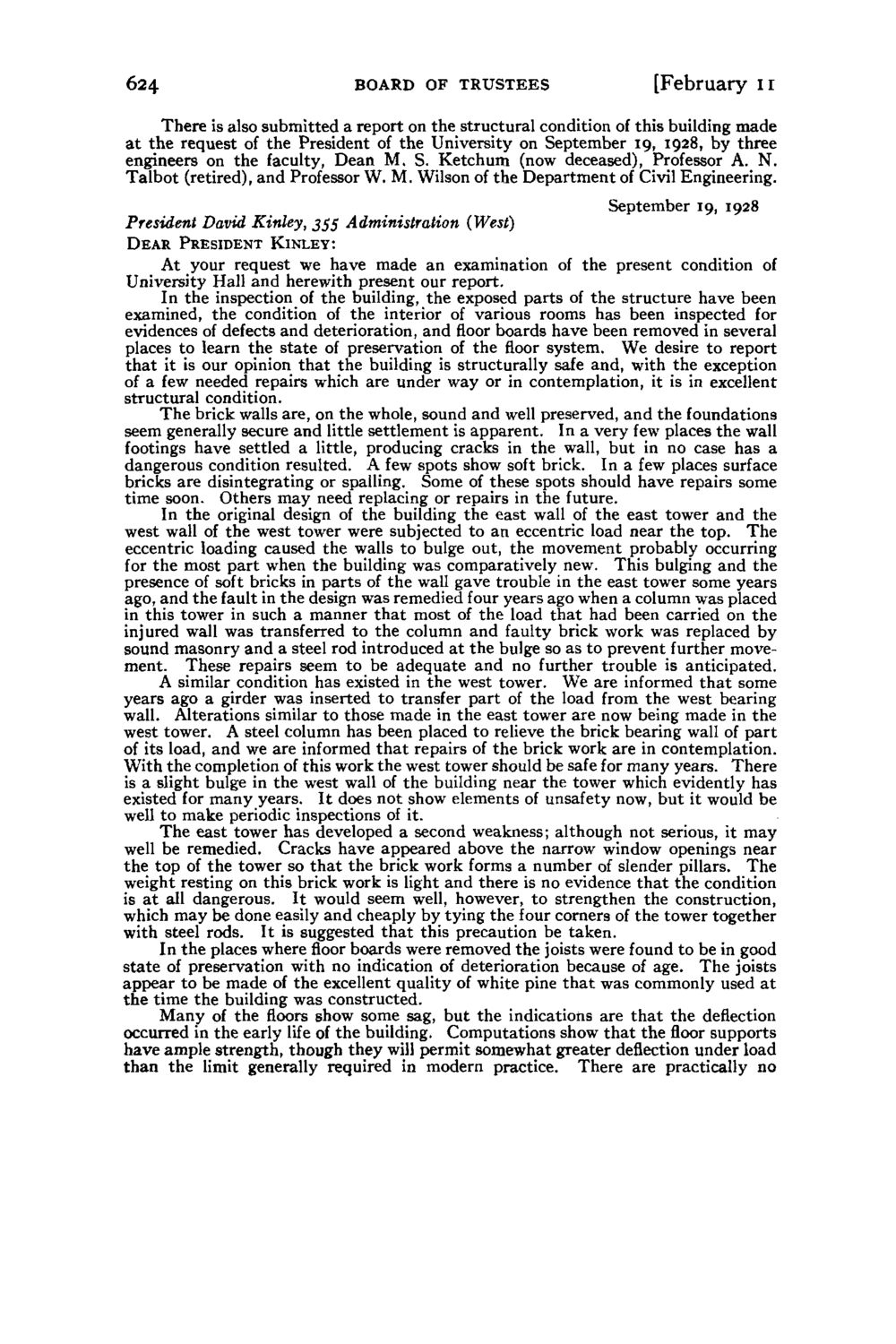| |
| |
Caption: Board of Trustees Minutes - 1938
This is a reduced-resolution page image for fast online browsing.

EXTRACTED TEXT FROM PAGE:
624 BOARD OF TRUSTEES [February ir There is also submitted a report on the structural condition of this building made a t the request of the President of the University on September 19, 1928, by three engineers on the faculty, Dean M. S. Ketchum (now deceased), Professor A. N . Talbot (retired), and Professor W. M. Wilson of the Department of Civil Engineering. September 19, 1928 President David Kinley, 555 Administration D E A R PRESIDENT K I N L E Y : (West) At your request we have made an examination of the present condition of University Hall and herewith present our report. In the inspection of the building, the exposed parts of the structure have been examined, the condition of the interior of various rooms has been inspected for evidences of defects and deterioration, and floor boards have been removed in several places to learn the state of preservation of the floor system. We desire to report that it is our opinion that the building is structurally safe and, with the exception of a few needed repairs which are under way or in contemplation, it is in excellent structural condition. T h e brick walls are, on the whole, sound and well preserved, and the foundations seem generally secure and little settlement is apparent. In a very few places the wall footings have settled a little, producing cracks in the wall, but in no case has a dangerous condition resulted. A few spots show soft brick. In a few places surface bricks are disintegrating or spalling. Some of these spots should have repairs some time soon. Others may need replacing or repairs in the future. In the original design of the building the east wall of the east tower and the west wall of the west tower were subjected to an eccentric load near the top. The eccentric loading caused the walls to bulge out, the movement probably occurring for the most part when the building was comparatively new. This bulging and the presence of soft bricks in parts of the wall gave trouble in the east tower some years ago, and the fault in the design was remedied four years ago when a column was placed in this tower in such a manner t h a t most of the load that had been carried on the injured wall was transferred to the column and faulty brick work was replaced by sound masonry and a steel rod introduced at the bulge so as to prevent further movement. These repairs seem to be adequate and no further trouble is anticipated. A similar condition has existed in the west tower. We are informed t h a t some years ago a girder was inserted to transfer part of the load from the west bearing wall. Alterations similar to those made in the east tower are now being made in the west tower. A steel column has been placed to relieve the brick bearing wall of part of its load, and we are informed t h a t repairs of the brick work are in contemplation. With the completion of this work the west tower should be safe for many years. There is a slight bulge in the west wall of the building near the tower which evidently has existed for many years. I t does not show elements of unsafety now, but it would be well to make periodic inspections of it. The east tower has developed a second weakness; although not serious, it may well be remedied. Cracks have appeared above the narrow window openings near the top of the tower so t h a t the brick work forms a number of slender pillars. The weight resting on this brick work is light and there is no evidence t h a t the condition is a t all dangerous. It would seem well, however, to strengthen the construction, which may be done easily and cheaply by tying the four corners of the tower together with steel rods. It is suggested t h a t this precaution be taken. In the places where floor boards were removed the joists were found to be in good state of preservation with no indication of deterioration because of age. The joists appear to be made of the excellent quality of white pine t h a t was commonly used a t the time the building was constructed. Many of the floors show some sag, but the indications are t h a t the deflection occurred in the early life of the building. Computations show t h a t the floor supports have ample strength, though they will permit somewhat greater deflection under load than the limit generally required in modern practice. There are practically no
| |